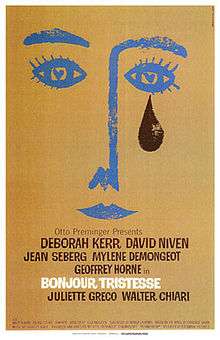Bonjour Tristesse (film)
| Bonjour Tristesse | |
|---|---|
 Film poster, designed by Saul Bass | |
| Directed by | Otto Preminger |
| Produced by | Otto Preminger |
| Screenplay by | Arthur Laurents |
| Based on |
Bonjour tristesse 1954 novel by Françoise Sagan |
| Starring | |
| Music by | Georges Auric |
| Cinematography | Georges Périnal |
| Edited by | Helga Cranston |
| Distributed by | Columbia Pictures |
Release dates |
|
Running time | 94 minutes |
| Country |
|
| Language | English |
Bonjour Tristesse (French "Hello, Sadness") is a 1958 British-American Technicolor film in CinemaScope,[1] directed and produced by Otto Preminger from a screenplay by Arthur Laurents based on the novel of the same title by Françoise Sagan. The film stars Deborah Kerr, David Niven, Jean Seberg, Mylène Demongeot and Geoffrey Horne, and features Juliette Gréco, Walter Chiari, Martita Hunt and Roland Culver. It was released by Columbia Pictures. This film had colour and black and white sequences, a technique unusual for the 1950s but widely used in silent movies and early talking films.
Plot
On the French Riviera, Cécile (Jean Seberg) is a decadent young girl who lives with her rich playboy father, Raymond (David Niven). Anne (Deborah Kerr), a mature and cultured friend of Raymond's late wife, arrives at Raymond's villa for a visit. Cécile is afraid that Anne will disrupt the undisciplined way of life that she has shared with her father.
Despite his promises of fidelity to Anne, Raymond cannot give up his playboy life. Helped by Elsa (Mylène Demongeot), Raymond's young and flighty mistress, Cécile does her best to break up the relationship with Anne. The combination of the daughter's disdain and the father's rakishness drives Anne to a tragic end.[2]
Cast
- Deborah Kerr as Anne Larsen
- David Niven as Raymond
- Jean Seberg as Cécile
- Mylène Demongeot as Elsa
- Geoffrey Horne as Philippe
- Juliette Gréco as Juliette Greco
- Walter Chiari as Pablo
- Martita Hunt as Philippe's Mother
- Roland Culver as Mr. Lombard
- Jean Kent as Mrs. Lombard
- David Oxley as Jacques
- Elga Andersen as Denise
- Jeremy Burnham as Hubert
- Eveline Eyfel as Maid
Critical reception
The film met with a lukewarm critical reception at the time. The BFI's Monthly Film Bulletin:[3] "The best performance is David Niven’s; he gives his part a pathetic touch that the writing never attains. Jean Seberg, who speaks rather than acts her lines, turns in the least effective performance. Bonjour Tristesse is an elegant, ice cold, charade of emotions, completely artificial and eventually torpid." Others enjoyed it rather more and it had some unexpected friends. François Truffaut described Seberg as “The best actress in Europe’. Jean-Luc Godard said "The character played by Jean Seberg [in Breathless] was a continuation of her role in Bonjour Tristesse, I could have taken the last shot of Preminger's film and started after dissolving to a title: "Three years later". A Guardian piece [4] in 2012 described it as “an example of Hollywood's golden age, and both its star and its famously tyrannical director are ripe for rediscovery.”
The film currently holds an 86% approval rating according to Rotten Tomatoes. Critic Keith Uhlich of Time Out New York wrote: "the director uses the expansive CinemaScope frame and his eye for luxuriant, clinical mise en scéne to soberly probe rather than gleefully prod. The cast is across-the-board exemplary. Niven and Kerr keenly satirize their onscreen iconographies—the cad and the goody-goody, respectively—but it’s Seberg who cuts deepest."
References
- ↑ "Bonjour Tristesse". Film & TV Database. British Film Institute. Retrieved 4 June 2013.
- ↑ Bonjour Tristesse (1957) – Trailers, Reviews, Synopsis, Showtimes and Cast. Allmovie.
- ↑ Monthly Film Bulletin, British Film Institute, No. 292. Vol. 25. May 1958. Page 55.
- ↑ Tony Paley (2012-10-10). "Bonjour Tristesse: a golden-age masterpiece ripe for rediscovery". The Guardian.
External links
- Bonjour Tristesse at AllMovie
- Bonjour Tristesse in the British Film Institute's "Explore film..." database
- Bonjour Tristesse at the Internet Movie Database
- Bonjour Tristesse at the TCM Movie Database
- Bonjour Tristesse at the American Film Institute Catalog
